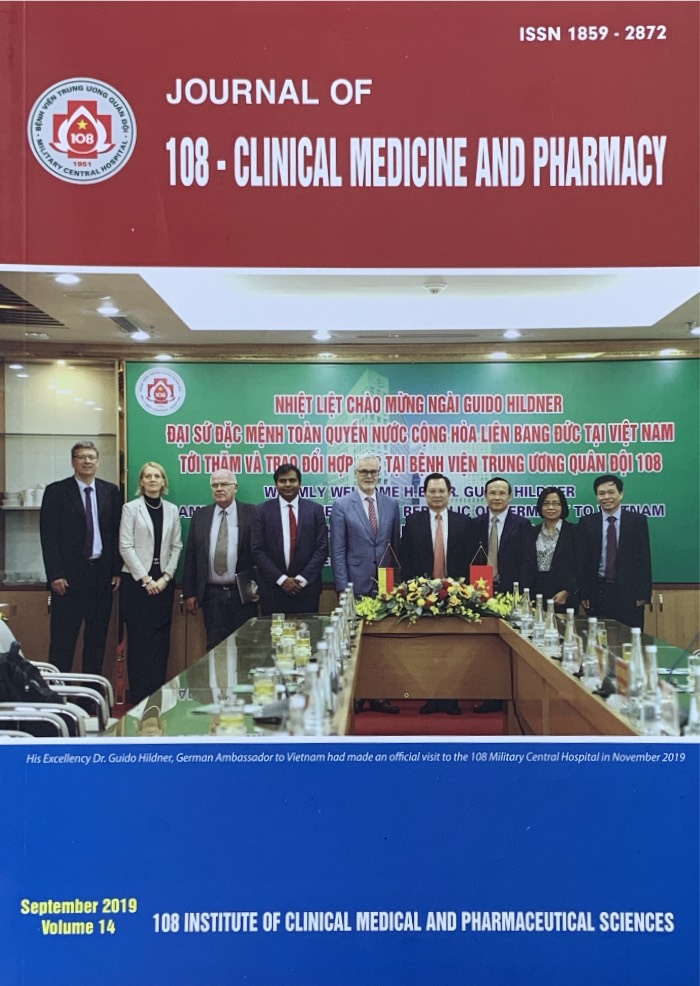Clinical manifestation, laboratory characteristics and predictors of severity in scrub typhus patients hospitalized in 103 Military Hospital and 108 Military Central Hospital
Main Article Content
Abstract
Objective: To investigate clinical manifestation, laboratory characteristics and predictors of severity in scrub typhus patients hospitalized in 103 Military Hospital and 108 Military Central Hospital. Subject and method: This was a descriptive study on 50 cases of scrub typhus confirmed by dot-ELISA or PCR hospitalized in 103 Military Hospital and 108 Military Central Hospital. Result and conclusion: There were 62% male and 38% female in our study. Patients in urban and non-urban accounted for 36% and 64%, respectively. The majority of patients had fever, headache and myalgia (> 96%) followed by eschar 70%, congested skin 60%, lymphadenopathy 44%, cough 42%, crackle 36%, dyspnea 22%. Thrombocytopenia and elevated liver enzyme accounted for 70% and more than 88, respectively. 100% patients had elevated PCT ( ± SD 2.396 ± 2.119ng/ml). Lung involvements on chest X-ray: Patchy opacity 8.7%, unilateral infiltrate 10.9%, bilateral infiltrate 8.7%. Pleural effusion and serous fluid on ultrasound were 30.8% and 33.3% respectively. Complications included respiratory failure 12%, septic shock 8%, and meningoencephalitis 8%, acute kidney injury 8%. Factors such as shortness of breath (OR = 6.6), respiratory rate ≥ 22 cycles/minutes (OR = 8.16), moist rale (OR = 14.25), increased PCT (AUC = 0.75), diffuse infiltration on X-rays (OR = 18), pleural fluid on ultrasound (OR = 5.17), have associated with the life-threatening complications (p<0.05).
Article Details
References
2. Taylor AJ, Paris DH, Newton PN (2015) A systematic review of mortality from untreated scrub typhus (Orientia tsutsugamushi). PLoS neglected tropical diseases 9(8): 0003971
3. Vu Trung N, Thuong NTH, Toan TK et al (2017) Seroprevalence of scrub typhus, typhus, and spotted fever among rural and urban populations of northern Vietnam. The American journal of tropical medicine and hygiene 96(5): 1084-1087
4. Hamaguchi S, Cuong NC, Tra DT et al (2015) Clinical and epidemiological characteristics of scrub typhus and murine typhus among hospitalized patients with acute undifferentiated fever in northern Vietnam. The American journal of tropical medicine and hygiene 92(5): 972-978
5. Trung NV, Le Thi Hoi VMD, Huong DT et al (2019) Clinical manifestations and molecular diagnosis of scrub typhus and murine typhus, Vietnam, 2015–2017. Emerging infectious diseases 25 (4): 633
6. Kim MH, Kim SH, Choi JH et al (2019) Clinical and laboratory predictors associated with complicated scrub typhus. Infection & chemotherapy 51(2): 161-170.
7. Biggs HM, Barton Behravesh C, Bradley KK et al (2016) Diagnosis and management of tickborne rickettsial diseases: Rocky Mountain spotted fever and other spotted fever group rickettsioses, ehrlichioses, and anaplasmosis United States: A practical guide for health care and public health professionals. MMWR Recomm Rep. 65(2): 1-44.
8. Jeong YJ, Kim S, Wook YD et al (2007) Scrub typhus: clinical, pathologic, and imaging findings. Radiographics 27(1): 161-172
 ISSN: 1859 - 2872
ISSN: 1859 - 2872
